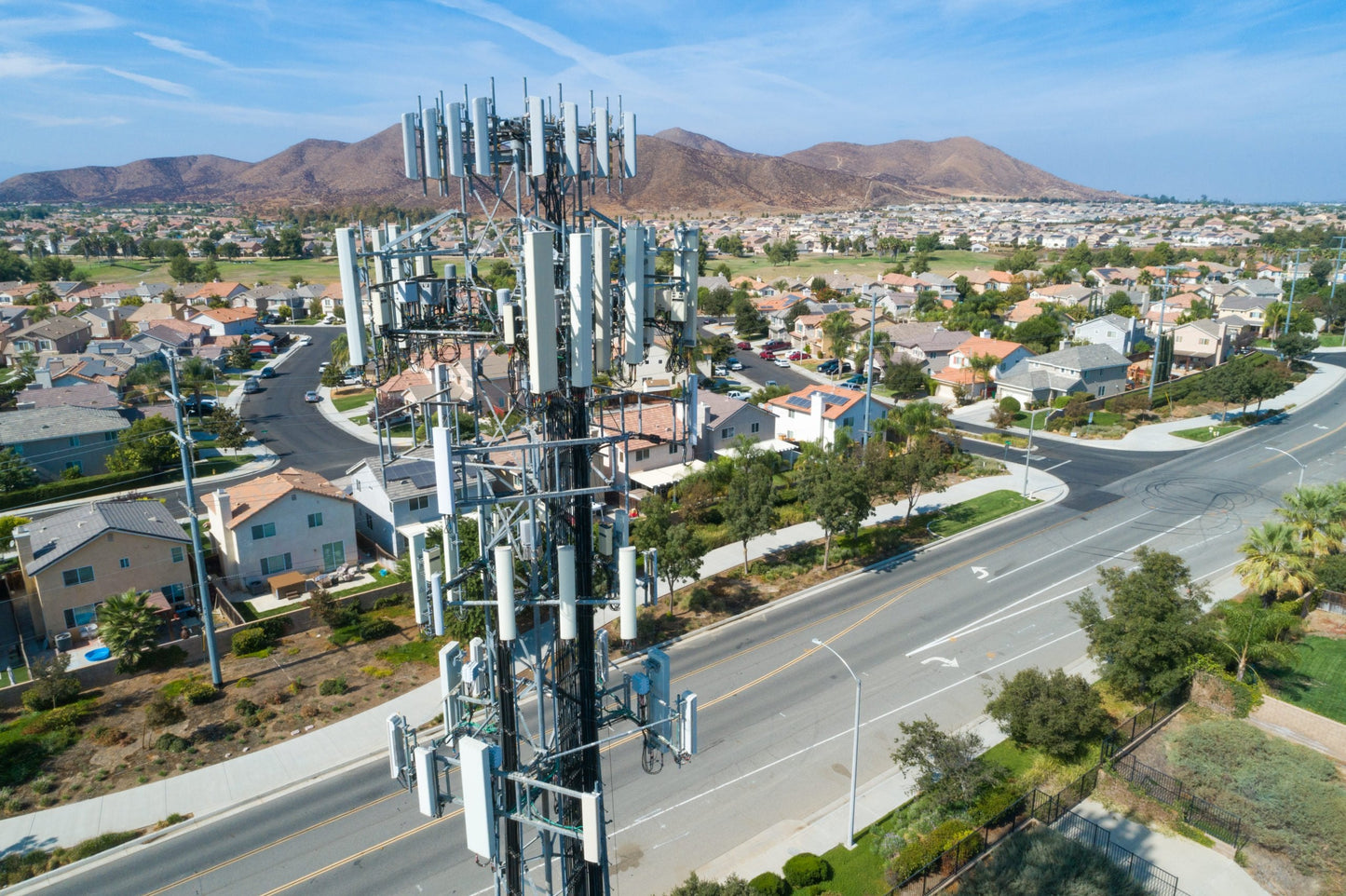
For our customers here at Blushield, the main cause for concern is the deleterious health effects of living so close to a cell tower, and we agree that this is the number one reason to be concerned! To read more about how and why EMFs are so harmful to the health of living organisms, browse our Education page for a lot more information.
Among the general public who aren’t necessarily aware of the health effects of EMFs, seeing a cell tower near their home is usually distasteful for other reasons.
The main concern in the minds of most people is aesthetic, especially in areas where natural features like trees, lakes and rivers are highly valued, and near historic points of interest where people want to maintain the authentic historical feel of an area that attracts tourists from all over. Another concern that’s related to aesthetics is an anticipated reduction of a homeowner’s property value from an unsightly cell tower. A big cell tower (or even a smaller antenna that’s visible) installed in a neighborhood is, quite frankly, an eyesore for almost anyone.
Is there any way we can gain awareness of new tower and antenna plans in our local areas prior to their installation, and then have a say in whether they are allowed to install them within our municipality? Yes! It can be a bit complicated legally in some circumstances, but we each have more say in this than we think. It just takes some study to grasp a basic understanding of the issue, and how we can play our part and make a difference.
Recent local area wins against cell tower installations
Americans for Responsible Technology (ART) is “a national coalition of grassroots organizations with a mission to stop the unconstrained proliferation of 5G small cell antennas and promote equitable access to technologies that benefit society and protect the health, safety, security, privacy and property of all Americans.”ART just reported on several local area legal wins against telecom applications to install towers. The local municipalities were able to reject the tower or antenna proposal through certain legally valid means.
In July of this year, Lakeland, Florida was able to reject a proposed 150-foot cell tower using aesthetic, historical and zoning arguments. The cell tower would have been installed very close to multi-family homes, a large lake that’s valued for its recreational opportunities, and historic Dixieland. The court voted 3-2 to reject the cell tower installation, citing that the tower would take up valuable, desirable land that could be used for family housing and recreation. Their explanation also emphasized the visual disturbance the tower would create for those wanting to enjoy beautiful views at nearby Lake Hunter, and an authentic experience in the historic district of Dixieland.
The city council in Brawley, California rejected the proposed installation of a cell tower in a residential area that includes a big park with baseball fields, a gymnasium, pool and skating rink. Many of the local residents attended the city council meeting and voiced their opposition to the tower being installed, even if it meant spotty T-Mobile coverage in the area. Many residents were concerned about the health effects that the big tower may have on their children who use the park, and others were concerned about it reducing their property values, and it having a “significant negative visual impact on the area”. The tower was rejected with a 5-0 unanimous vote.
A proposal for a 125-foot AT&T cell tower in Loudoun County, Virginia, was rejected 8-1 last month by the Loudoun County board of supervisors. The tower would have been built on top of the Short Hill Mountain ridgeline, and although that would have improved coverage in the surrounding area, the sight of the tower and the environmental impact of the monopole and ground facility were undesirable to the vast majority of residents and local government. The tower installation would have run counter to the Loudoun land use plan that states that towers need to be built on the downslope of the ridgeline, not the top. Local residents argued that their current cell phone coverage is not really in crisis, and that the land use plan also protects the environmental and scenic qualities of the county’s prime viewsheds. Short Hill Mountain is an important feature in the iconic visual experience from one of the most popular short hikes on the Appalachian National Scenic Trail, Weverton Cliffs in central Maryland.
“To make a permanent environmental change for a short term technological issue — when you have technological advances that are happening every five, 10, 15 years with huge advances — I’m not going to do anything that is environmentally harmful for a short-term technological gain,” says Loudoun County chairwoman Phyllis Randall.
The city council of Sylvania, Ohio, voted unanimously to reject a proposal to install a 140-foot Verizon cell tower at Northview High School. The ART organization assisted the residents of Sylvania in defeating this ill-sited tower proposal.
The biggest recent win for activists was the veto of California State Bill 556. The bill was introduced in February, and after months of non-stop lobbying, letter writing campaigns, testifying at public hearings, and much more, the governor vetoed the bill. SB 556 was a telecom-industry sponsored bill that would have removed significant local control over the deployment of 5G antennas in communities across the entire State of California.
Resources to help you take local action
The Americans for Responsible Technology website contains a freely available 5G Activist Toolkit, which includes sample letters and flyers that can be customized and sent to your local officials, neighbors and schools, a sample small cell code for villages, towns and small cities, and information on successful lobbying and legislative outreach. It is a fantastic resource that we encourage everyone to explore to see how they can participate in making positive change in their local area!It’s important to voice your concerns about the potential health hazards of radiation from nearby cell towers, but ART states that the most consistent winning strategy for fighting unwanted cell towers is arguing that the tower will impose an eyesore on your community, devalue nearby properties, and/or have a detrimental visual impact on surrounding historic areas.
They also emphasize ensuring that your local telecommunications ordinance is up-to-date and contains specific language to protect residents of your community from ill-sited 5G "small cell" antennas. They wrote a simple Checklist for Municipal Codes Addressing Small Cell Installations as a resource to help any local municipality cover their bases and create appropriately difficult hoops for telecoms to jump through that will ensure they don’t force their way into a community that doesn’t want or need their products and services.
How can you stay informed about proposals for future tower installations in your area? You can file a FOIL (Freedom of Information Law) request on your locality’s website. Ask to review all pending applications for wireless telecommunications facilities within a one-mile radius of your home. Contact your local clerk if you have questions or concerns about how to do this. To be able to take action against a new cell tower proposal, it’s best to know about it in advance, so this is an important step!
These are great ways to get started taking local action to keep your neighborhood free of unwanted radiation and environmental clutter. Please pass this information on to anyone you know who is interested and would benefit from it!
References:
Americans for Responsible Technology: 5G Activist Toolkit – https://www.americansforresponsibletech.org/tool-kitAmericans for Responsible Technology: Checklist for Municipal Codes Addressing Small Cell Installations – https://ed84ae68-328e-42f4-847a-66fb863ac9df.filesusr.com/ugd/2cea04_125c2a55c01e4bd6b3b2b800426d9fa7.pdf
California SB-556 Street light poles, traffic signal poles: small wireless facilities attachments – https://leginfo.legislature.ca.gov/faces/billNavClient.xhtml?bill_id=202120220SB556
“Brawley says no to cell tower” – https://www.thedesertreview.com/news/brawley-says-no-to-cell-tower/article_be4e9012-2687-11ec-8db7-ff196f6fffcd.html
U.S. District Court, Tampa Division: North American Towers LLC vs. City of Lakeland – https://drive.google.com/file/d/1UduHGlTiyfgbFpDRAAHpTtu0yTwVT7jS/view
“Loudoun supervisors deny proposed AT&T cell tower” – https://www.loudountimes.com/news/loudoun-supervisors-deny-proposed-at-t-cell-tower/article_0323db26-2632-11ec-ab90-9f404beb2700.html

